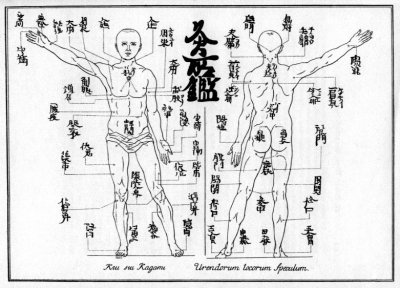White Crane Centre
Goju ryu, Kyusho jitsu, Krav Maga, Kobudo.
What is Kyusho Jitsu

Kyusho jitsu
Introduction Kyusho jitsu is the doctrine of the body's vital points to distract or weaken an opponent. In the martial arts, we can influence the body by either holding, pressing, rubbing or hitting various points. By influencing a point, we affect the flow of energy and thus the body's communication system. Kyushon's different principles make it possible to combine almost endlessly different methods, where some combinations are more powerful than others, depending on technology and circumstance.
Why? Kyusho jitsu is very effective in self-defense and requires no strength. The downside is that it takes time to learn because it requires PRECISION, INTENTION and RELAXATION and perhaps not least BELIEVE in one's own ability. The least effect kyusho jutsu usually gives us is that we temporarily weaken the opponent's muscles and make his joints give way more easily. But we can also have a stronger effect on our opponent by temporarily or partially affecting the nervous system in such a way that his level of consciousness and muscle control is completely or partially disturbed. There are usually three different degrees: • 3rd degree: Temporary loss of or lack of muscle control and / or consciousness. Usually a 2-point combination or a light 3-point combination. Grade 2: Complete loss of muscle control. However, the opponent may at least be somewhat aware of his surroundings. Usually a 3-point combination. 1st degree: Complete "unconsciousness". The opponent is lying down and has no muscle control at all and is completely unaware of the surroundings. Usually a 4-point combination or a hard 3-point combination.
Energy In the body, just as in the universe, there are all forms or frequencies of energy. The smallest constituents we know of atoms are actually energy that vibrates or oscillates at a speed so that they are perceived as particles. The interesting difference between different particles or matter is really with what frequency it vibrates / oscillates. Frequency determines how we "perceive" energy. There is solid matter (minerals, proteins etc), liquid (water, blood, lymph etc), gas (oxygen, nitrogen, carbon dioxide etc), measurable, stronger electromagnetic radiation (heat, bioelectricity etc) and weaker, more subtle energy (aura , thoughts, feelings etc). All these forms of energy interact and transform with each other. You can in principle influence all forms of energy with any form of energy. Of course, sound is also energy, with different frequencies. The sound waves hit us at over 300 meters / second. Thoughts travel faster than light.
Ki Some of the electromagnetic energy is called ki by the Japanese, chi / qi by the Chinese and prana by the Indians. Electromagnetic energy is present throughout the body and around the entire body. Outside the body, we generally call it the aura. Energy that moves, or "flows", along pathways within the body we call ki and the pathways acupuncture meridians. Places on the body where energy flows between the inside and outside of the body we call chakras and acupuncture points. Chakras can be said to be large acupuncture points where the energy flow affects large nerve accumulations (so-called plexus), internal organs and glands. There are seven larger chakras and a large number between and smaller chakras.
Acupuncture points - nerve points In kyusho you learn the same points that are used in acupuncture and acupressure. The body's vital points, or acupuncture points (also called nerve points), are places on the body where one can affect the body's energy system (ki) and nervous system. Acupuncture points are usually a place on the body where we can access where a nerve ends, divides or crosses other nerves. There are 361 regular points along 14 meridians and in addition there are at least as many extraordinary points.
Nervous system A large part of the body's internal communication takes place via the nervous system. Nerves are long cells that carry electrical impulses. Nerve cell is both receiver and transmitter of impulses. Impulses between nerve cells and nerve cells and other types of cells occur through either electrical or chemical stimulation from other cells. In some places, nerve cells stop or branch off. At these branches, the electrical impulses are thus passed on via several paths. But for a nerve cell to send out an electrical or chemical impulse, it must be given a sufficient dose of stimulation. If the irritation is too small, it means that the nerve cell does not send any impulse further, while an excessive excitation can mean that the system is short-circuited. To protect the system against either a short circuit or a stop, there are fuses / switches built in - traffic lights at the various intersections, you could say. The acupuncture points and their electromagnetic voltage are the traffic lights and the meridians are the traffic lights' communication and control systems.
Meridians There are 12 regular meridians, six yin and six yang, which are bilateral, ie. they are mirror-inverted on the right and left sides of the body. In addition, there are two meridians that run along the center line of the body. The meridians are associated and named after different internal organs depending on which vital organ the meridian mainly regulates. The meridians are different flows of energy in the body that can be compared to how water flows in nature. At the beginning of the meridian, ki is stored as in a deep well or underground lake. Then ki "rises" and flows as from a source to then increase in strength and flow as (in) a rapids. After the rapids, the flow becomes like a river to eventually become like a river delta. A large part of the meridian flow takes place inside the body and cannot be shown by simply following the points of a meridian on the outside of the body.
